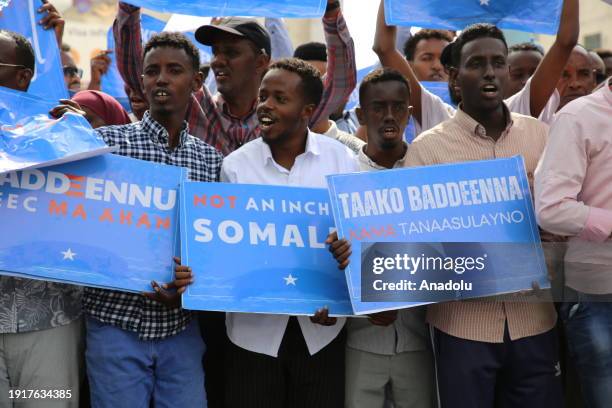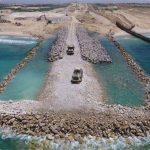Abstract
The recent agreement between Ethiopia and Somaliland has raised concerns about its potential impact on the stability and economic dynamics of East Africa. This paper examines the implications of the deal on regional geopolitics, trade, and security. It also explores the potential challenges and opportunities that may arise from the agreement and offers policy recommendations for mitigating potential risks.
Key Themes
- Regional Geopolitics and Stability
– The implications of the Ethiopia-Somaliland agreement on regional power dynamics.
– Assess potential shifts in alliances and rivalries within East Africa.
– The impact of external powers on regional stability and conflict.
- Economic Opportunities and Challenges
– The economic benefits of increased access to the Red Sea for Ethiopia.
– The implications for trade routes and logistics in East Africa.
- Security Concerns and Implications
– Investigate the security risks associated with the agreement, including piracy and regional instability.
4. Somalia’s Reaction and Territorial Integrity
– The Somalia’s response to the agreement and its implications for regional diplomacy.
– The consequences of Somaliland’s aspirations for recognition and autonomy.
– The legal and political ramifications of the agreement on Somalia’s territorial claims.
5. Future Prospects for Regional Cooperation
– The potential avenues for fostering collaboration among Horn of Africa countries.
– The opportunities for joint development initiatives that can enhance regional stability.
– The strategies for managing conflicts over resources and territory in the context of the agreement.
Introduction:
The strategic partnership between Ethiopia and Somaliland has sparked debates about its potential consequences for the broader East African region. As Ethiopia seeks to expand its access to seaports and enhance its economic prospects, the implications of this agreement on regional stability, trade routes, and geopolitical dynamics cannot be overlooked. This paper aims to analyze the potential ramifications of the Ethiopia-Somaliland deal and provide insights into its broader implications for East Africa.
Ethiopia’s strategic interests have escalated as it seeks to gain access to all seaports in the Horn of Africa region. The regional project aims to ensure the economic progress of Ethiopia and overcome its status as a landlocked country. To enhance Ethiopian endeavors, the project focuses on owning shares in seaports in the region. Before 2018, Ethiopia’s focus was on the Ethiopian regional project, which aimed to unify the Horn of Africa as an economic bloc, with the navy playing a major role.
Since Abiy Ahmed assumed power in April 2018, Ethiopia has adopted port diplomacy to overcome its geographical limitations. After Eritrea gained independence in 1993, Ethiopian policy shifted towards finding alternatives to seaports in neighboring countries to ensure trade flow to and from Addis Ababa through the Red Sea or the Indian Ocean.
Ethiopia has signed agreements with neighboring countries such as Djibouti, Somalia, Kenya, Sudan, and Somalia to use their seaports and obtain shares in them. This facilitates Ethiopian trade with the outside world and strengthens strategic relations with Eritrea following the peace agreement in 2018. In 2018, the Ethiopian Naval Force was re-established with French assistance, positioning Ethiopia to lead the region within the framework of the Regional Integration Initiative.
History and Geopolitics
The port of Berbera is strategically located in the Gulf of Aden, which has historically attracted foreign powers. Connecting the Arabian Sea, Indian Ocean, and Red Sea via the Bab-el-Mandeb strait, the Gulf of Aden serves as a crucial passageway for energy resources and international trade between West Asia, the North Atlantic region, Asia, and Europe. It is a vital waterway for global energy security and the world economy.
The increase in piracy off the coast of Somalia, a weak and unstable state, highlights the need for global and regional powers to establish a presence in the region to safeguard shipping and oversee events in and around the Gulf of Aden.
In the early 20th century, Britain acquired a part of the Somali coast, including Berbera, forming British Somaliland. The Somali coast was colonized by three different players: France occupied Djibouti, Britain controlled the north of British Somaliland, and Italy controlled Italian Somaliland to the south. Britain prioritized control over Aden for the security of its interests in the Indian Ocean, using the port of Aden in Yemen as a relay and resupply point between Europe and the Far East.
The importance of Berbera increased significantly after decolonization and the emergence of Somalia as an independent state in the late 1960s. Soviet Russia began expanding its strategic role in the littoral African states, developing military facilities such as Berbera, Mogadishu, and Kismayo. Berbera emerged as an important Soviet military base with air and naval capabilities.
However, after siding with Ethiopia in the war against Somalia, the Soviet Union lost access to these facilities, allowing the US to gain access through its support of Somalia. Following the Cold War, the US presence in the region declined, and the port’s importance diminished. Nevertheless, the port remained crucial for the newly independent Somaliland and landlocked Ethiopia.
Ethiopia was once considered an important Red Sea power due to its control over the coastline, which is now part of Eritrea. The war between Eritrea and Ethiopia from 1998 to 2000 cut off Ethiopia’s access to Eritrean ports such as Massawa and Assab. As a result, Djibouti became overwhelmingly important as a conduit to the sea for Ethiopia. Currently, 95% of Ethiopia’s international trade passes through Djibouti.
As trade volumes and dependence on Djibouti grew, Ethiopia had to modernize the port of Doraleh in the 2000s. DP World played a critical role in the modernization and operation of the port, making it capable of handling large container vessels. With Ethiopia’s rapid economic rise , Doraleh became the only port in the region capable of handling such vessels.
Why Sign the Memorandum of Understanding: Assessing the Implications of the Ethiopia-Somaliland Agreement for East Africa?
The memorandum of understanding was signed and is not a legally binding agreement. Firstly, the memorandum includes that Somaliland is prepared to grant Ethiopia access to the sea for the movement of its commercial ships through one of the ports in the country. Secondly, it allows landlocked Ethiopia to lease 20 kilometers around the port of Berbera on the Gulf of Aden, giving it access to the Red Sea for a period of 50 years for its maritime and commercial purposes. In exchange, Ethiopia recognizes Somaliland as an independent state. Thirdly, the port will provide Ethiopia with access to the Red Sea and the Suez Canal, enabling it to reach Europe.
The agreement, signed in Addis Ababa, also grants Ethiopia a 50-year lease on a naval base with access to the port of Berbera in Somaliland for commercial maritime operations. This will allow Addis Ababa to diversify its access to seaports. The agreement aims to deepen relations between the two parties in the economic and political sectors.
Previously, there was controversy surrounding the port of Berbera. In 2019, Ethiopia acquired a 19 percent stake in the port, while Somaliland retained 30 percent and DP World owned 51 percent. This was in exchange for financing the continued development of the port, amounting to approximately $442 million, with DP World managing the port. However, the deal was met with opposition, and Parliament passed a resolution to cancel and invalidate it. Despite this, the project continued. In return for the memorandum of understanding, Somaliland will receive a stake in Ethiopian Airlines, a successful airline in the country.
Somalia’s Stance on the Memorandum of Understanding: Implications for Regional Dynamics in the Horn of Africa
Somalia rejected the agreement, and Somali President Hassan Sheikh Mohamud quickly signed a law canceling the memorandum of understanding. The United States and the African Union also supported Somalia’s territorial integrity.
Ethiopia’s Reaction to Somalia: Navigating Diplomatic Challenges in the Horn of Africa
The Prime Minister emphasized that Ethiopia’s presence is linked to the Red Sea, and stated that if the countries of the Horn of Africa want to live together peacefully, they must find a balanced way to share resources. Ethiopia, the most populous landlocked country in the world, lost its ports after Eritrea seceded in the early 1990s, and has mainly relied on Djibouti for its port operations.
Ethiopia-Somaliland Agreement: Controversial Impact
For Somalia, Somaliland is an integral part of its territory. Therefore, any suggestion of making a deal with another country or leasing parts of it without Mogadishu’s consent is a significant problem.
Signing the memorandum of understanding was seen as an act of aggression and an obstacle to peace and stability, leading Somalia to recall its ambassador from Addis Ababa. The president’s speech was particularly threatening to neighboring countries, as he vowed to defend the country by any means necessary and called on young people to prepare for defense. As a result, tens of thousands of people in Mogadishu protested against the agreement.
Somaliland has been operating independently since its secession in 1991, despite its limited resources and lack of access to international trade. The state even prints its own passports and holds elections. However, under international law, Somaliland is recognized as part of Somalia. The situation is further complicated by regional rivalries and geopolitics, making the deal problematic and potentially increasing tensions between Somalia and Ethiopia.
Ethiopia’s Strategic Shift and the Future of Regional Access to the Sea
Future Planning for Ethiopia: The Dispute with Egypt over the Grand Ethiopian Renaissance Dam Work on the Grand Ethiopian Renaissance Dam began in 2011, and in July 2020, Ethiopia announced that it was filling its reservoir, marking an important stage in the project. The dam is expected to be operational by the end of 2022.
Egypt has hardened its position, expressing concerns about its water security. It accuses Ethiopia of being uncooperative by refusing to conduct studies on the environmental and social impact of the dam and submit to oversight. Egypt is also worried about the economic implications, as it currently pays approximately two billion US dollars annually to countries in the region to secure export and import movement. By reducing these costs, Ethiopia aims to achieve significant financial returns, with around $13 billion in imports and $3 billion in exports.
Addis Ababa is actively seeking to strengthen its economic and trade leverage. In 2022, its total trade with the world reached $19.2 billion, reflecting a 4.3% increase from the previous year. The security forces are strategically focused on the Red Sea region due to recent turmoil. This includes Operation Al-Aqsa Flood in 2023 and the subsequent escalation of Houthi attacks on ships carrying goods to Israel. The concern has further intensified with the resurgence of Somali pirate activity.
What Can We Expect in the Future?
There is a possibility of a new regional war, with regional countries having economic and strategic interests in pushing Addis Ababa towards accessing the Red Sea. This could lead to the formation of new alliances, with Ethiopia playing a major role. Ethiopia’s goal is to weaken the positions of Egypt and Djibouti, as Egypt finds itself on the brink of war with Ethiopia due to the dam issue.
Ethiopia has garnered support from Western countries, challenging international laws, conventions, and human rights norms. This has occurred in the aftermath of conflicts in Gaza and Ukraine. If regional, Arab, and Western countries continue to reject the memorandum of understanding, it may compel Addis Ababa to avoid escalating the crisis and instead seek alternative paths to secure a seaport.
Conclusion
Future planning for Ethiopia: Initially, Egypt is in dispute with Ethiopia over the Grand Ethiopian Renaissance Dam. The dam, launched in 2011, began an important stage in July 2020 when Ethiopia announced it was filling its reservoir. The dam may be operational before the end of 2022. Egypt has hardened its position, fearing for its water security, and has accused Ethiopia of intransigence for refusing to conduct studies on the environmental and social impact and submit to oversight.
International focus: Ethiopia is primarily motivated by economic factors, aiming to reduce the high cost it pays to secure export and import movement in the region. This cost amounts to approximately two billion US dollars annually, with the potential for significant financial returns ($13 billion in imports and about 3 billion in exports). Addis Ababa is striving to enhance its economic and trade leverage. In 2022, its total trade with the world reached 19.2 billion US dollars, marking a 4.3% increase from the previous year.
Security concerns: The security forces are strategically focused due to the turmoil in the Red Sea since Operation Al-Aqsa Flood in 2023. The situation worsened with the escalation of Houthi attacks on ships loaded with goods heading towards Israel, and the return of Somali pirate activity. This has raised concerns about the security of the Red Sea once again.
What to expect in the future: There is a possibility of a new regional war, with regional countries having economic and strategic interests in pushing Addis Ababa towards the Red Sea. This could result in the formation of new alliances in the region, with Ethiopia playing a major role. The goal would be to weaken the position of Egypt and Djibouti, as Egypt is on the brink of war with Ethiopia due to the dam issue. Ethiopia’s actions challenge international laws, conventions, and human rights norms, especially after recent conflicts in Gaza and Ukraine.
If regional, Arab, and Western countries continue to reject the memorandum of understanding, it may push Addis Ababa to avoid escalating the crisis and instead search for ways to secure a seaport. Ethiopia, the largest landlocked country in the world, supports the development of a modern port in Berbera and seeks to take advantage of its concessions. It relies on Djibouti as its main channel to the sea and welcomes UAE investments in Somaliland. Plans are in place to build the Berbera Corridor, a special economic zone, and to modernize communications infrastructure, including roads and railways. These developments are likely to enhance economic development in Somaliland and the southern and eastern regions of Ethiopia. However, Ethiopia still desires control.
It is expected that the future will witness a change in the political geography of a region marked by conflicts and tensions. Addis Ababa is determined to access a seaport to meet the needs of its population of 120 million people. However, these justifications seem to contradict reality and indicate Ethiopian ambitions towards the ports of Somalia, particularly the port of Berbera, which aligns with the interests of Somaliland, the United Arab Emirates, and Ethiopia. Engaging in new conflicts in the region will come at a high cost for Ethiopia and will not provide an easy solution. We will likely witness a third war.




Allison1305
https://myteana.ru/forums/index.php?autocom=gallery&req=si&img=6611
Rosa833
Good https://is.gd/tpjNyL
Miral Sabry AlAshry - Hussein AlWaeli
Thanks
Hope3915
Very good https://is.gd/tpjNyL
Frida148
Good https://is.gd/tpjNyL
Hank4591
Awesome https://is.gd/tpjNyL
Leland1672
Very good https://shorturl.at/2breu
Annie2195
Awesome https://shorturl.at/2breu
Ariana785
Very good https://shorturl.at/2breu
Marina1738
Good https://shorturl.at/2breu
Darren3481
Very good https://shorturl.at/2breu
Lorraine82
Good https://shorturl.at/2breu
Barry4127
Very good https://lc.cx/xjXBQT
Oscar2732
Awesome https://lc.cx/xjXBQT
Elsie781
Awesome https://lc.cx/xjXBQT
Easton2207
Good https://lc.cx/xjXBQT
Alec4304
Good https://short-url.org/10VGf
Allan3410
Good https://t.ly/tndaA
Pamela1437
Very good https://t.ly/tndaA
Sally4794
Awesome https://is.gd/N1ikS2
Cynthia1127
Good https://is.gd/N1ikS2
Ingrid22
Very good https://is.gd/N1ikS2
Lawrence3459
Awesome https://is.gd/N1ikS2
Giovanni4417
Very good https://is.gd/N1ikS2
Jude4006
Very good https://is.gd/N1ikS2
Makenzie2390
Very good https://is.gd/N1ikS2
Elsie1985
Awesome https://is.gd/N1ikS2
Clark2231
Good https://is.gd/N1ikS2
Allen1924
Very good https://is.gd/N1ikS2
Madelyn2726
Awesome https://is.gd/N1ikS2
Cindy4254
Very good https://is.gd/N1ikS2
Hailey325
Very good https://is.gd/N1ikS2
Hamilton361
Awesome https://is.gd/N1ikS2
Isabelle234
Good https://is.gd/N1ikS2
Paula4590
Good https://is.gd/N1ikS2
Zoe531
Awesome https://is.gd/N1ikS2
Sharon2563
Awesome https://is.gd/N1ikS2
Jacqueline1798
Awesome https://is.gd/N1ikS2
Jolene1885
Cool partnership https://shorturl.fm/FIJkD
Angelina3888
Good https://shorturl.fm/j3kEj
Kaylee1220
Good partner program https://shorturl.fm/N6nl1
Clarissa3907
https://shorturl.fm/6539m
Clyde4302
https://shorturl.fm/A5ni8
Bradley888
https://shorturl.fm/XIZGD
Alyssa723
https://shorturl.fm/5JO3e
Donovan4616
https://shorturl.fm/XIZGD
Josie616
https://shorturl.fm/XIZGD
Emma4294
https://shorturl.fm/PFOiP
Theodore2477
https://shorturl.fm/TDuGJ
Penelope4636
https://shorturl.fm/DA3HU
Dalton2545
https://shorturl.fm/PFOiP